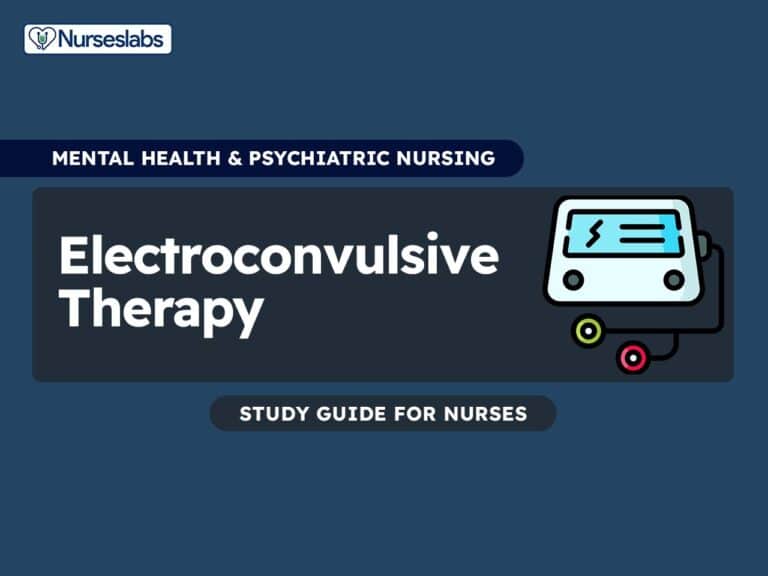Electroconvulsive Therapy (ECT) is a medical procedure used to treat severe mental health disorders, especially when other treatments have been ineffective.
This study guide provides a comprehensive overview of ECT, including its procedure, indications, mechanisms, benefits, risks, and nursing responsibilities.
What is Electroconvulsive Therapy (ECT)?
Electroconvulsive therapy (ECT) is a procedure in which electric currents are passed through the brain, deliberately triggering a brief seizure. Electroconvulsive therapy seems to cause changes in brain chemistry that can immediately reverse symptoms of certain mental illnesses. It often works when other treatments are unsuccessful.
Indication
ECT is primarily employed in cases where severe mental disorders exhibit treatment resistance or immediate intervention is essential. Common indications include:
- Severe major depressive disorder.
- Bipolar disorder, especially during manic or depressive episodes.
- Catatonia, a state of profound motor and psychological disruption.
- Schizophrenia, particularly when accompanied by severe symptoms or catatonia.
- Suicidal ideation or behavior that poses an imminent risk.
Mechanism of Action
The exact mechanisms of ECT’s therapeutic effects are not entirely understood, but it is believed to induce neuroplastic changes and alter neurotransmitter levels. ECT stimulates a controlled seizure in the brain, leading to the release of neurochemicals that can reset abnormal brain activity and alleviate severe symptoms.
Benefits of ECT
ECT offers several benefits for patients with severe mental health disorders:
- Rapid symptom relief: ECT can bring relief from severe symptoms quicker than other treatments.
- Reduced suicide risk: ECT can rapidly alleviate suicidal thoughts and behaviors.
- Effective in treatment-resistant cases: ECT often works when other treatments have failed.
- Improved quality of life: Successful ECT treatment can significantly enhance an individual’s overall well-being.
Risk and Side Effects
While ECT can be highly effective, it’s not without risks and potential side effects:
- Memory loss: Temporary memory impairment, especially regarding events around the time of treatment.
- Confusion: Patients may experience confusion and disorientation immediately following treatment.
- Physical discomfort: Some patients report headache, muscle soreness, and nausea.
- Risks associated with anesthesia: General anesthesia is used during ECT, carrying its own set of potential risks.
- Rare risks: These include cardiovascular complications and fractures due to muscle contractions during seizures.
Emotional and Educational Support to the Client & Family
- Encourage the client to discuss feelings, including myths regarding ECT.
- Teach the client and the family what to expect with ECT.
Nursing Care Before ECT
- Ascertain if the client and the family have received a full explanation, including the option to withdraw the consent at any time.
- Withhold food and fluids for 6 to 8 hours before treatment.
- Remove dentures, glasses, contact lenses, hearing aids, hair pins and etc.
- Have the client void before the treatment.
- Give preoperative medications as ordered:
- Give either glycopyrrolate (Robinul) or atropine to prevent the potential for aspiration and to help minimize bradyarrhythmias in response to electrical stimulants.
Nursing Care During ECT
- Place a blood pressure cuff on one of the client’s arms.
- As the intravenous line is inserted and EEC and ECG electrodes are attached, give a brief explanation to the client.
- Put on the pulse oximeter on the client’s finger.
- Monitor blood pressure throughout the treatment.
- Medications to be given:
- Short-acting anesthetic (Brevital)
- Muscle relaxant (Succinylcholine)
- 100% oxygen by mask via positive pressure
- Check if the bite block is placed to prevent biting of the tongue
- An electrical stimulus was given (the seizure should last 30 to 60 seconds).
Nursing Care After ECT
- Have the client go to a properly staffed recovery room.
- Once the client is awake, talk to the client and check the vital signs.
- Give frequent orientation and reassurance to allay confusion.
- Check the gag reflex before giving the client fluids, medications, or breakfast.

I love the notes and your good at it